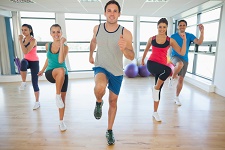Approximately half your body weight is muscle tissue. There are three types of muscles, which are cardiac, skeletal and smooth muscles. Cardiac muscle appears striated. It is located in the heart walls and moves involuntarily. Skeletal muscle is attached to the bones and is under voluntary control. Smooth muscle appears spindle-shaped, and is located in the walls of hollow organs like the uterus, intestine, bladder, blood vessels -except the heart. This muscle also moves involuntarily.

Muscular System Functions
1. Mobility
The central nervous system controls the skeletal muscle fibers for voluntary movement, by means of the muscles' contraction and relaxation. Actions like running, jumping, walking, dancing or chewing among others are done with the help of skeletal muscles.
2. Communication
The muscles we need for speaking and writing are also skeletal muscles. They can be controlled by our central nervous system which tells those muscles what to do and how to do it. The skeletal muscles make it possible for us to say or write anything we want.
3. Maintenance of Posture
Contrary to what many people believe, we are not in a relaxed condition while sitting or standing. We can maintain such positions because there are constant contraction and relaxation of responsible muscles. Babies who have not yet learned how to control these muscles and people with muscular diseases can’t sit straight and need an extra support to do so.
4. Digestion
While putting food in our mouth, chewing and swallowing are all voluntary movements, but what happens next is out of your control. The food goes down our esophagus and into our stomach where it starts to process with stomach acid. Then it continues its way through the small and large intestines, and finally gets into the rectum where it is discharged in the form of feces. These involuntary digestive movements are called peristalsis and are carried by smooth muscles.
5. Body Temperature Maintenance
There are several mechanisms by which the body maintains body temperature, and the main one is through skeletal muscular movement.
- When muscles move, heat is produced. This is why when we are cold, we will start to shiver uncontrollably.
- When we exercise, our body temperature rises. In this condition, our muscles will redirect this excess of heat to the skin in the form of sweat, thus cooling down our bodies.
Maintaining a constant temperature is very important, because all physiological, cellular and biochemical processes are done at a specific range of temperature in our body.
6. Blood Circulation
One of muscular system functions is the blood circulation. The cardiac muscles are responsible for the blood pumping through the whole body, with the help of the smooth muscles in blood vessels and skeletal muscles.
Cardiac muscles and smooth muscles are in charge of carrying the oxygenated blood from the heart to all the organs, muscles and tissues of the body, and carry all the deoxygenated blood back to the heart again. They do these processes continuously without stopping through all our life. Skeletal muscles' movements can help improve the efficiency of the whole process.
7. Shock Absorption
The muscles act as cushions to protect bones and organs. This is because the agonist and antagonist movements and the contraction movements of muscles can help absorb impacts, and reduce friction and stress in joints and other tissues.
How to Take Care of Your Muscular System
1. Eat a Balanced Diet

In order to ensure normal muscular system functions, having a balanced diet is very important.
- Proteins are fundamental for muscle growth and maintenance, and these can be found in lean meats, fish, poultry, eggs, seafood, nuts, soy, dry beans and some seeds.
- Carbohydrates are the muscle fuel since they provide all the energy needed for everyday activities. Sources of carbohydrates include whole grains, vegetables and fruits.
2. Stay Hydrated

Muscle soreness and cramping are very common if you are dehydrated. This can be easily prevented by drinking lots of water through the day and especially during workout sessions.
3. Warm Up and Stretch

The risk of muscle and tendon strains reduces significantly if you take some time before a workout to do some stretches. Stretches will increase the temperature and blood flow into the tissues to activate them.
Walking and jogging are good ways to initiate any exercise. Take 10 to 15 minutes before any activity to warm up and do some stretches.
4. Try Resistance Training

This type of training is done by lifting weights, and is the kind of exercise that bodybuilders do. Resistance training will increase muscular mass, strength and resistance to carry heavy weights.
5. Do Aerobic Exercise

This include walking, jogging, dancing, swimming and any other activities in which the priority is to burn calories and improve cardiovascular health. This kind of exercise will burn fat, and increase indurance and muscle tone.
6. Correct Posture
Having a correct posture will benefit your bones, muscles and joints. Usually when an activity or workout is performed, all these body elements must be conjoined in order to effectively accomplish the task. If there is a muscular unbalance, all the other structures will be compromised, therefore affecting the activity.
- If you are seated on a chair, your column must be straight and your shoulders should face against the back of the chair.
- While standing or walking, keep your back straight and do not slump.
7. Maintain Normal Weight
Excessive weight can put stress on muscles, so you should try to keep a normal weight to keep muscular system functions normal, and avoid muscle strains and aches. To do this, you should:
- Have healthy diets and balance your calorie intake with proteins, carbohydrates and fats.
- Do aerobic exercise to burn extra fats, and lift some weights to increase your muscle mass and muscles can burn more calories.